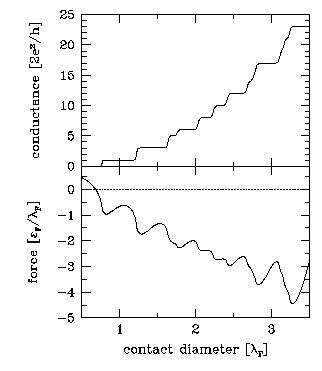

 Scattering approach to nanocohesion and
conduction
Scattering approach to nanocohesion and
conduction
The cohesive force of a nanometer-sized contact between two macroscopic pieces of metal is provided largely by the electrons which are transmitted through the contact. Such a contact acts as a wave-guide for electrons, and only certain discrete modes are transmitted, leading to quantization of the electrical conductance, and to quantum oscillations of order 1 nano-Newton in its cohesive force. See the following articles for more:
Publications
- C. A. Stafford, D. Baeriswyl and J. Bürki,
Jellium model of metallic nanocohesion,
Phys. Rev. Lett. 79, 2863 (1997).
- C. A. Stafford,
Quantum theory of metallic nanocohesion,
Physica E 1, 310 (1997).
- F. Kassubek, C. A. Stafford and H. Grabert,
Force, charge, and conductance of an ideal metallic nanowire,
Phys. Rev. B 59, 7560 (1999).
- J. Bürki, C. A. Stafford, X. Zotos, and D. Baeriswyl,
Cohesion and conductance of disordered metallic point contacts,
Phys. Rev. B 60, 5000 (1999).
- J. Bürki and C. A. Stafford,
Comment on ``Quantum Suppression of Shot Noise in Atom-Size Metallic Contacts,''
Phys. Rev. Lett. 83, 3342 (1999). - C. A. Stafford, J. Bürki, and D. Baeriswyl,
Comment on ``Density Functional Simulation of a Breaking Nanowire,''
Phys. Rev. Lett. 84, 2548 (2000).
- C. A. Stafford, F. Kassubek, J. Bürki, H. Grabert, and D. Baeriswyl,
Cohesion, Conductance, and Charging Effects in a Metallic Nanocontact,
in ``Quantum Physics at the Mesoscopic Scale,'' D. C. Glattli, M. Sanquer, and J. Tran Thanh Van eds.
(EDP Sciences, Les Ulis, France, 2000), pp. 49-53.
- C. A. Stafford,
Metal Nanowires: Quantum Transport, Cohesion, and Stability,
Phys. Stat. Sol. (b) 230, 481-489 (2002).
